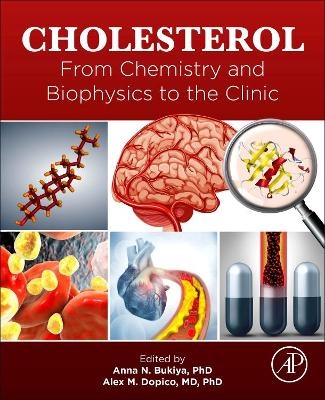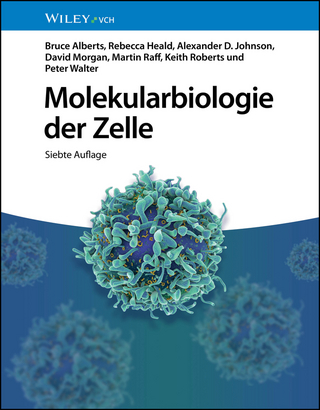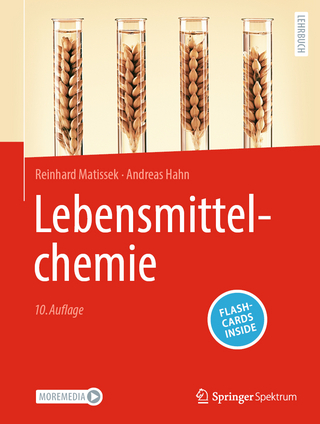
Cholesterol
Academic Press Inc (Verlag)
978-0-323-85857-1 (ISBN)
Cholesterol: From Biophysics and Biochemistry to Pathology and Pharmacology empowers researchers, students, and clinicians across various disciplines to advance new cholesterol-based studies, improve clinical management, and drive drug discovery.
Dr. Anna Bukiya’s PhD laboratory focuses on lipid modulation of ion channel function in excitable tissues and sensitivity to drugs. Dr. Bukiya’s work has been consistently funded by the NIH and private foundations, and she has published 43 original research articles, authored or co-authored 10 reviews, and 9 book chapters. Dr. Bukiya also co-edited two books and served as a sole editor on one book, all focused on the role of lipids in modulating protein function during normal physiology and pathological conditions. The Bukiya laboratory utilizes computational modelling of cholesterol-protein interactions, biochemical and fluorescence microscopy-based quantification of cellular cholesterol levels, rat models of high-cholesterol diet, and statin use to control cholesterol levels in vivo. Dr. Bukiya is a current member of several societies, including Biophysical Society, International Drug Abuse Research Society, and American Society for Pharmacology and Experimental Therapeutics. Dr. Alex Dopico MD, PhD received his M.D. from the University of Buenos Aires, specializing in arterial hypertension. Following his Ph.D. in Pharmacology, he conducted postdoctoral training at UMass Worcester focusing on the regulation of ion channels by lipids and alcohols. Over two decades, the Dopico laboratory has addressed ion channel regulation by a wide variety of lipids, including fatty acids, leukotrienes, glycerophospholipids, PIP2 and related phosphoinositides, bile acids and other cholanes, pregnenolone and cholesterol itself. His studies on alcohol and toluene aim at determining the relative contribution of ion channels and their surrounding membrane lipids to drug action, addressing the impact of drug action on organ function, with a focus on cerebral arteries. In 2009, he received a Merit Award from NIAAA for his work on ethanol actions on slo1 channels. He is member of the National Advisory Committee on Alcohol Abuse & Alcoholism.
Part 1. Cholesterol Chemistry and Cell Function
1. Cholesterol chemistry, and laboratory synthesis
Hélio M.T. Albuquerque, Clementina M.M. Santos, and Artur M.S. Silva
2. Molecular evolution of cholesterol and other higher sterols in relation to membrane structure
Ole G. Mouritsen
3. Role of cholesterol in maintaining the physical properties of the plasma membrane
Witold K. Subczynski, Marta Pasenkiewicz-Gierula, Justyna Widomska, and Natalia Stein
4. The fundamental interaction of cholesterol with lipid membranes: The umbrella model
Juyang Huang
5. Model peptides and cholesterol
István P. Sugár and Parkson Lee-Gau Chong
6. Cholesterol and ceramide: An unlikely pair
Aritz B. García-Arribas, Alicia Alonso, and Félix M. Goñi
7. Cholesterol-recognizing amino acid consensus motifs in transmembrane proteins: Comparative analysis of in silico studies and structural data
Fodil Azzaz, Henri Chahinian, Nouara Yahi, Coralie Di Scala, Carlos J. Baier, Francisco J. Barrantes, and Jacques Fantini
8. Effects of cholesterol on the GPCR AT1 receptor and its interplay with AT1 antagonists
S. Kiriakidi, Z. Cournia, and T. Mavromoustakos
9. Principles of cholesterol regulation of ion channels
Qiu-Xing Jiang and Irena Levitan
10. Fluorescent probes for microscopy visualization of cholesterol topography and dynamics in membranes
Francisco J. Barrantes
11. Cholesterol transport in blood, lipoproteins, and cholesterol metabolism
Mark T Mc Auley and Amy E Morgan
12. Common laboratory research methods for detection and quantification of cholesterol
Anna N. Bukiya, Hanxuan Li, Steven Mysiewicz, and Wei Li
Part 2. Cholesterol Homeostasis and its disruption
14. Diet-induced hypercholesterolemia in small laboratory animal models
Tina Herfel
15. Nutrition and cholesterol metabolism
Ghada A. Soliman
16. Cholesterol and early development
Isabella Ellinger and Waranya Chatuphonprasert
17. Clinical and biochemical diagnostic methods: What do blood lipid levels tell us?
Marshall B. Elam
18. Familial hypobetalipoproteinemia and abetalipoproteinemia
Francine K. Welty
19. Critical illness and cholesterol levels
Zdenek Zadak
20. Familial hypercholesterolemia
Shifa Jebari-Benslaiman, Unai Galicia-Garcia, Asier Larrea-Sebal, Kepa B. Uribe, Cesar Martin, and Asier Benito-Vicente
21. Niemann-Pic type C disease (NPC)
Agnieszka Ługowska
22. Rare monogenic disorders of cholesterol metabolism
Malgorzata Bednarska-Makaruk and Agnieszka Ługowska
23. Secondary (acquired) hypercholesterolemia
Arrigo F.G. Cicero and Ivan R. Cincione
24. Blood lipids and molecular pathways of atherogenesis
Ricardo Stein, Filipe Ferrari, and Vítor M. Martins
25. Lysosomal acid lipase: Roles in rare deficiency diseases, myeloid cell biology, innate immunity, and common neutral lipid diseases
Gregory A. Grabowski and Hong Du
26. Cholesterol and pathogens
Tatiana M. Clemente and Stacey D. Gilk
27. Involvement of cholesterol and ß-amyloid in the initiation and progression of Alzheimer’s disease
Luis G. Aguayo, Jorge P. Roa, Carlos F. Burgos, and Juliana Gonzalez-Sanmiguel
28. Cholesterol and alcohol
Andrew S. Bell, Emma M. O’Connell, and Falk W. Lohoff
Part 3. Pharmacological Considerations and Perspectives
29. Cholesterol stiffening of lipid membranes and drug interactions: Insights from neutron spin echo and deuterium NMR spectroscopy
Sudipta Gupta, Fathima T. Doole, Teshani Kumarage, Milka Doktorova, George Khelashvili, Rana Ashkar, and Michael F. Brown
30. Cholesterol in drug delivery systems
DanRong Hu and ZhiYong Qian
31. Modification of vascular receptor pharmacology by cholesterol: From molecular determinants to impact on arterial function
Alex M. Dopico, Anna N. Bukiya, and Kelsey C. North
32. Clinical strategies for reducing cholesterol levels
Claude K. Lardinois and Samantha Karr
33. Medicinal chemistry and pharmacology of statins
Bob M. Moore, II and George A. Cook
34. Cyclodextrins as promising therapeutics against cholesterol overload
Florina Zakany, Tamas Kovacs, Lajos Szente, and Zoltan Varga
35. Hyperlipidemia and rheumatoid arthritis
Aliki I. Venetsanopoulou, Paraskevi V. Voulgari, and Alexandros A. Drosos
36. Management of hypercholesterolemia in individuals living with HIV/AIDS
Musaab Ahmed, Marium Ahmed, Dushyant Mital, and Mohamed H Ahmed
| Erscheinungsdatum | 06.05.2022 |
|---|---|
| Zusatzinfo | 160 illustrations (60 in full color); Illustrations |
| Verlagsort | Oxford |
| Sprache | englisch |
| Maße | 191 x 235 mm |
| Gewicht | 450 g |
| Themenwelt | Naturwissenschaften ► Biologie ► Biochemie |
| Naturwissenschaften ► Biologie ► Genetik / Molekularbiologie | |
| ISBN-10 | 0-323-85857-0 / 0323858570 |
| ISBN-13 | 978-0-323-85857-1 / 9780323858571 |
| Zustand | Neuware |
| Informationen gemäß Produktsicherheitsverordnung (GPSR) | |
| Haben Sie eine Frage zum Produkt? |
aus dem Bereich


